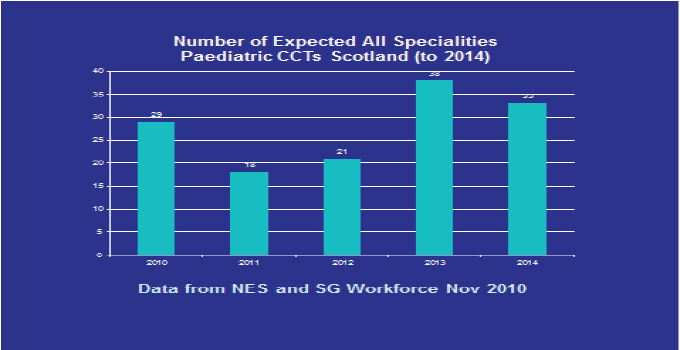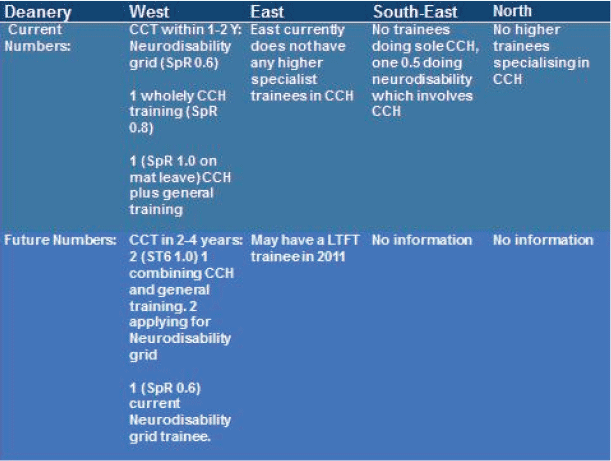Developing a community child health service for the 21st century
A report on a review of the community child health service in Scotland.
Section 12: Paediatric trainee demographics in Scotland
In 2005 the start of Modernising Medical Careers ( MMC) established 'run-through' training for doctors, whereby doctors enter a training scheme at ST1 after two foundation years ( FY1&2) and emerge after ST7 with a certificate of completion of training ( CCT).
The number of doctors entering paediatrics at ST1 has been directly linked to consultant requirements and over the years has been reduced to bring the number entering training and those completing training into balance with the number of expected vacant consultant posts. There has been a gradual absorption of doctors already in training since the scheme started with the expectation that a bulge of trainees will emerge in 2013-14 with a CCT (see graph below).
However there is some uncertainty in these predictions as trainees may be on flexible programmes or take out of programme experience (eg overseas or to do research). There is an attrition (loss of trainees from the scheme) rate of 2-5% and currently a 10% vacancy rate amongst all ST posts in Scotland. The trainee numbers have not taken into account CCH vacancies, probably because the majority of these vacancies were in the SASG as opposed to the consultant grade.
Figure 18: Expected Paediatric CCTs to 2014

Current CCH Trainee Numbers
A recent poll of the NES Deaneries in Scotland was not encouraging in terms of current trainees undertaking higher training in CCH or neurodisability.
Note: Neurodisability is a subspecialty within CCH. Doctors trained in this area may take on some generic duties in CCH and may contribute to a regional paediatric neurology service depending on local need and the skills of the individual. Paediatric Neurodisability ( PND) subspecialty training is allocated as part of a National Grid Scheme in the UK. The Chair of the PND College Specialty Advisory Committee ( CSAC), Dr Karen Horridge, provided the following information regarding PND training in Scotland:
2009 Grid entry: One NE Scotland; Two West Scotland (slot sharing)
2010 Grid entry: One SE Scotland (0.5)
2011 Grid entry: One West of Scotland
PND grid slots will be allocated "according to perceived need" and may result in fewer non-specialist CCH trainees in a Deanery because of the pressure on slots from other paediatric subspecialty grid schemes.
Deaneries in Scotland have reported there are no CCH trainees in the East, South-east or North Deaneries (See Table 1). The postgraduate advisor in the West Deanery has advised that around one trainee "with some CCH interest" will achieve their CCT each year. NES colleagues have advised that the calculation of ST numbers to date has not taken account of workforce requirements in CCH, so there has been limited central direction regarding numbers of trainees with enhanced experience in CCH/ PND. Although there will be substantial numbers of trained paediatricians emerging in the next few years (2013-2014), most of them will have limited experience in CCH. After that numbers will reduce gradually. In the current year ST1 numbers are still being debated but between 16-24 are anticipated.
Table 1: Deanery Responses regarding CCH Specialist Trainees

Summary
Given the age profile of the CCH medical workforce, it appears that the current number of trainees in the system are insufficient to replace expected retirals of trained doctors in CCH. Even if a model of paediatrician who undertake duties in both community and acute sectors is adopted, further training in CCH, including enhanced CPD opportunities will be required. The SACCH questionnaire revealed that over half of consultant paediatricians who are undertaking some duties in CCH have had under 6 months training. Over a quarter had had no training at all. Given the complexity and challenges of CCH work, there needs to be a review of the paediatric training strategy to ensure sustainability of the workforce.
Contact
- Mary Sloan mary.sloan@gov.scot
There is a problem
Thanks for your feedback